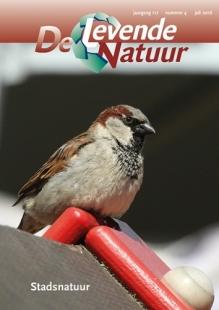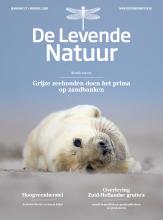De Levende Natuur nummer 4 van 2016 (English summary)
Thema
Afbeelding

10 years of urban bird conservation
L.H. Louwe Kooijmans, R.G.M. Kwak & J. Schoppers
The House sparrow became Red Listed in The Netherlands in 2004 and this drew attention to the fact that cities were rapidly degrading as bird habitat. This gave rise to a conservation program for urban birds. The action plan on urban bird conservation has two goals: improve cities as a habitat for birds and engage citizens by giving the opportunity to act. BirdLife Netherlands / VBN stands for the conservation of all indigenous birds and their habitat. Reality shows that even the most common bird, House sparrow, can be endangered within decades, as its urban habitat has deteriorated. Therefore VBN promotes the ‘basic quality of nature’, in order to keep the common birds common. A benchmark for urban birds shows the relative species richness of a location. For both the benchmark and the state of the urban birds, the bird species are lumped in ‘guilds’ not based on biological family but on landscape use. In this way the guilds give a direct implication of the conservation measurements needed in a certain location e.g. city.
Urban Nature has the future
R.P.H. Snep
In The Netherlands nature conservation is all about rural nature; so far urban nature has received little attention. In this article the author argues why urban nature nevertheless is of increasing importance for nature conservation in general: 1) the former typical Dutch rural landscapes – small-scaled, with the high biodiversity levels we often refer to in conservation – will not return in the future, as there is no new economic demand for these landscapes anymore; 2) new generations grow up in cities with or without nature in their urban vicinity, determining their attitude towards wildlife conservation; 3) the urban habitat is becoming more species-rich as more and more species colonise cities; 4) urban ecosystems act as living labs for future realities in The Netherlands like warmer conditions; impacts of e.g. climate change on nature can be observed here first. Based on these arguments, several action perspectives for conservations have been listed to deal with urban nature. These perspectives are illustrated by projects of the author originating from 25 years of experience with applied urban ecology research and practice: 1. Think ‘out of the box’ while searching for conservation opportunities in urban areas. 2. Consider urban nature conservation from a strategic point of view. 3. Involve urban actors, however each on their own way. 4. Make use of the societal attention for sustainable urban development to create opportunities for nature-inclusive buildings. By implementing these perspectives in city practice, conservationists in the Netherlands may contribute to more societal support for nature and to more resilient wildlife.
City in development – butterflies as bridge builders
D. Gorissen & V. Persoons
The city of Lommel (Flanders, Belgium) has a high natural value, but is also facing some typical challenges in terms of urbanization. By generating partnerships with other governments and private landowners, the city takes the challenge to reconcile a dynamic urban development with quality of life and the protection of its valuable nature. Butterflies are used as indicators and as a symbol.
Nature in the city center of Leuven
W. Verheyden
This article presents the results of three projects about nature in the city of Leuven (Belgium) -two of them about urban nature in general and one about wild bees- and some new initiatives that have started in the aftermath of these projects. General conclusions clearly confirm the importance of local policy for urban nature conservation and development, based on three pilars: nature-friendly green management, spatial planning with respect for nature and environmental policy in general (e.g. to improve water quality, etc.). As knowledge gaps are gradually closed, additional efforts are often needed to avoid implementation gaps. Also communication and awareness-raising are important aspects of that effort.
Tracking wildlife in town and harbour: urban ecology in Rotterdam
A. de Baerdemaeker, M.A.J. Grutters, W. Moerland, G. Bakker, R.G.W. Andeweg & N. de Zwarte
In 1997 the municipality of Rotterdam and the Natural History Museum joint forces to create awareness on wildlife in the urban habitat in general and Rotterdam in particular. This led to the formation of Bureau Stadsnatuur, the urban ecology department of the Natural History Museum. The new found Bureau started to collect historical data on wildlife and performed their own research right away, but lacked sufficient manpower. So the help of the public was needed. A long term citizens science project was launched to collect data on different species groups through standardized monitoring schemes. The project ran from 1997 to 2011, when it ended because of funding cuts. In the meantime several professional ecological monitoring projects were started in different cities. Standardized counts are used to calculate population trends. In the course of a few years these projects will shed light on developments in urban nature.
Some of the most noteworthy changes in a town’s biodiversity are the appearances of new species and the disappearance of old ones. For instance the Slender Blue-winged Grasshopper (Sphingonotus caerulans) and Speckled wood (Pararge aegeria) have colonized Rotterdam in recent decades, while Red squirrel (Scurius vulgaris) has vanished.
Big urban parks are slowly changing with the years. As they get older, final stages of succession will be reached and new plant and animal species will seize the opportunity. In such areas, tree nesting birds and bats rise. Man himself also has a big part in urban ecological processes. The way parks are managed plays a crucial role for a large number of species, which is most easily shown by the way damselflies like the Azure bluet (Coenagrion puella) respond to changes in water management. Of course the same applies for large scale development projects, which alter the landscape in a short amount of time. Their effects are highly visible in breeding bird populations.
In the port of Rotterdam dynamics are also high. Because of the unique circumstances in this industrial landscape, an evenly unique species composition can be found. The insect fauna is remarkable with high densities of certain sensitive species of butterflies and (more visible) large colonies of gulls and terns.
These examples show we are getting a clearer picture of which species inhabit our cities. But this is only the beginning. To further understand underlying dynamics, a lot more work has to be done.
Urban birds count: Monitoring Urban Species its tenth year
J. Schoppers, C.A.M. van Turnhout, L.H. Louwe Kooijmans & T. van der Meij
In 2007 Sovon Dutch Centre for Field Ornithology and Birdlife the Netherlands started a breeding bird monitoring program for urban populations, MUS (Monitoring Urban Species). The field work method consists of five minute point counts on 8-12 randomly selected points per postal code area. Per year each point is counted three times, divided over the periods 1-30 April, 15 may- 15 June (both dawn) and 15 June-15 July (evening, especially for Swift). In 2007-2015 the number of points counted increased from 4,950 to 6,930. About 30% of the 750 volunteer participants is female, and half of the participants did not participate before in other national bird monitoring schemes. Urban population trends could be calculated for 76 species. Nine species showed a strong decline in numbers in 2007-2015, 22 a moderate decline, 18 were stable, 18 showed a moderate increase and nine species a strong increase. For typical urban species the balance was even more negative: 11 species showed a decrease, 7 an increase and one species was stable. In general, the majority of species that nest in trees and shrubs is declining, whereas most species that nest near water are increasing. MUS data also enable relative density calculations for several urban habitats and offer the possibility to compare these between cities.
Urban ecology and insects
T.J.A. Faasen
Industrialized regions and especially city parks can contribute to the preservation of biodiversity, especially the smaller fauna, e.g. insects, because these are indifferent to human presence, capable of surviving in small habitats and mostly able to bridge the omnipresent landscape barriers. Most interesting from a conservation perspective within the Dutch context are species that are historically not exclusively found in cities, but are threatened outside cities due to intensification of land use.
Measures for these insects can range from widely applicable ‘no regret’-measures to comprehensive measures aiming to realize complete ecosystems similar to those found in nature reserves. The latter require insight in local opportunities and a focus on accentuating landscape differences and gradients, enlarging the availability of microhabitats and also preserving present valuable environmental conditions and valuable (relict) species. In this context it is desirable to acknowledge the value of stability, continuity and reduced vitality.
Long term planning, alertness to ecological opportunities and broad scope gathering of species presence data are strongly recommended. To interpret the available species data and prioritise different measures it might be helpful to consult a specialist in this field.
School pond adoption programme Eindhoven, wildlife education in the city
P.A.M. van Leeuwen-de Bruijn
Recently, Dutch policy makers and conservationists focus on how to involve society in an active way into nature and nature management. In this perspective, children are an interesting group, as they may intensively enjoy nature while being child but also remember these wildlife experiences for decades. With more children growing up in cities, providing nature education opportunities in cities is essential for them.
This article describes a successful wildlife education programme for primary schools in the city of Eindhoven. The idea of the programme is that school classes adopt a neighboring pond, do some management work and monitor its wildlife (particularly the amphibians). In the 15 years running this programme, it developed from 1 involved school with 50 participating children into 35 schools with 3500 children, which means impacting half of the Eindhoven’s primary schools participating in a structural way. Including teachers, (grand)parents and neighboring citizens the programme reaches thousands of urban dwellers.
Special measures are made not to transfer infections and exotic invasive plants and fish from one pond to another.
The collaboration among nature education, teaching and landscaping professionals implemented into the city’s environmental education on primary schools, is a valuable investment in young people who grow up and play an active part in the development of a resilient urban wildlife.
The Kanaalpark in ‘s-Hertogenbosch as a natural connection in the city
J.J.J.A. Willems
The Kanaalpark in ‘s-Hertogenbosch is an urban nature park designed to act as a compensatory measure for nature loss caused by the construction of the Máximakanaal in 2014. It also serves as a connection between existing nature in the surrounding area. To survey the mammals and birds currently using the park a monitoring program was commenced by students of HAS University of Applied Sciences in 2015. The first results indicate that birds and mammals pre-existing in the area, as well as species from surrounding areas, already use the park as their new habitat or as a migration route. Although the monitoring program has to be adjusted at some minor points, these first results indicate an early success of the Kanaalpark. Further development of the park and its vegetation in the following years can allow more animals to inhabit the park as it gets more excluded from the city’s liveliness.

